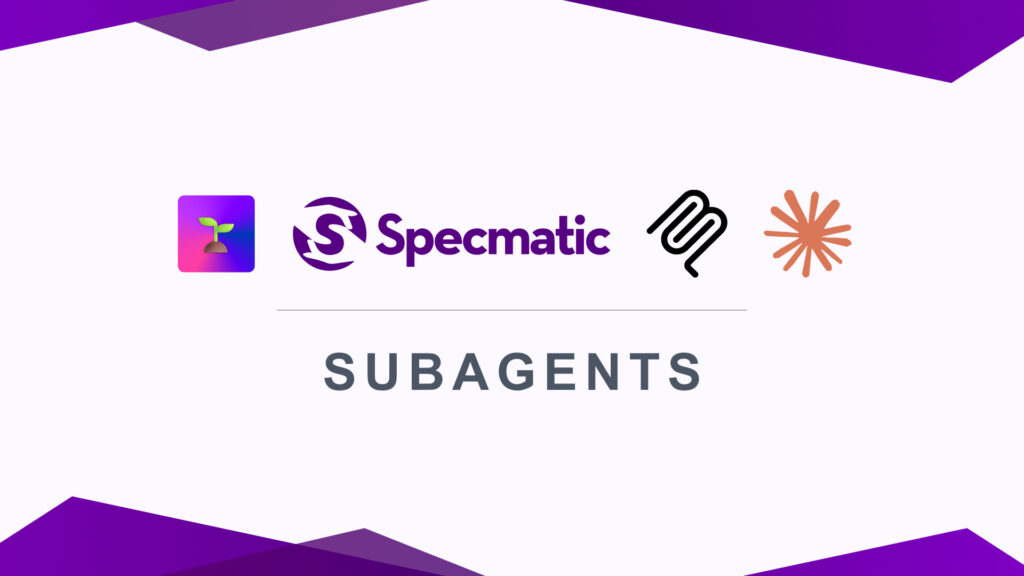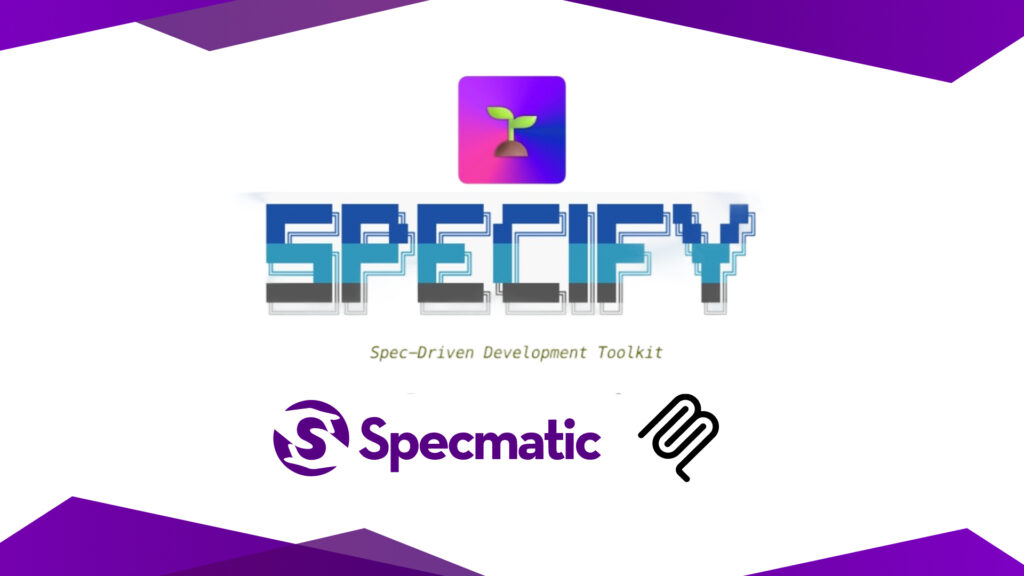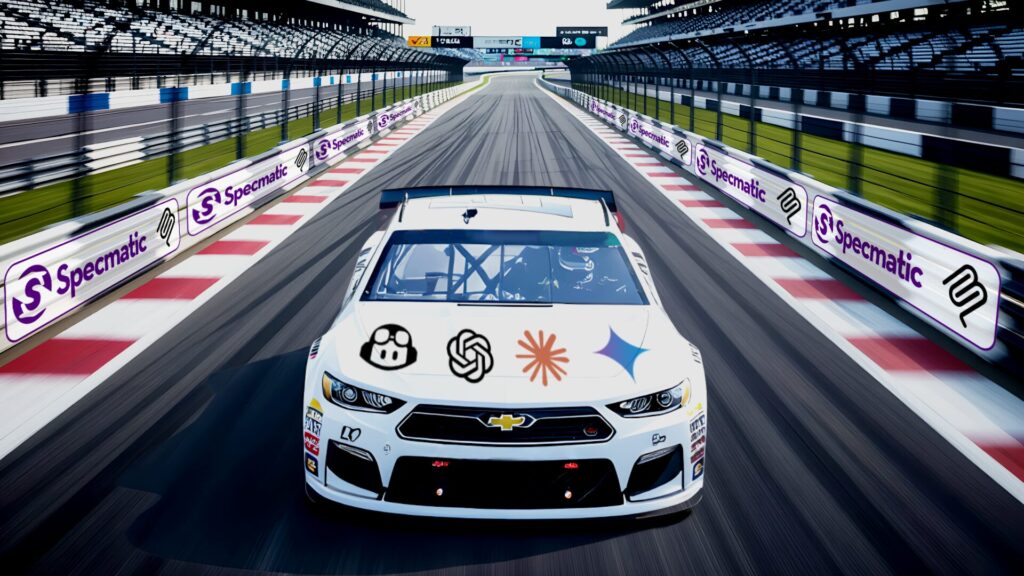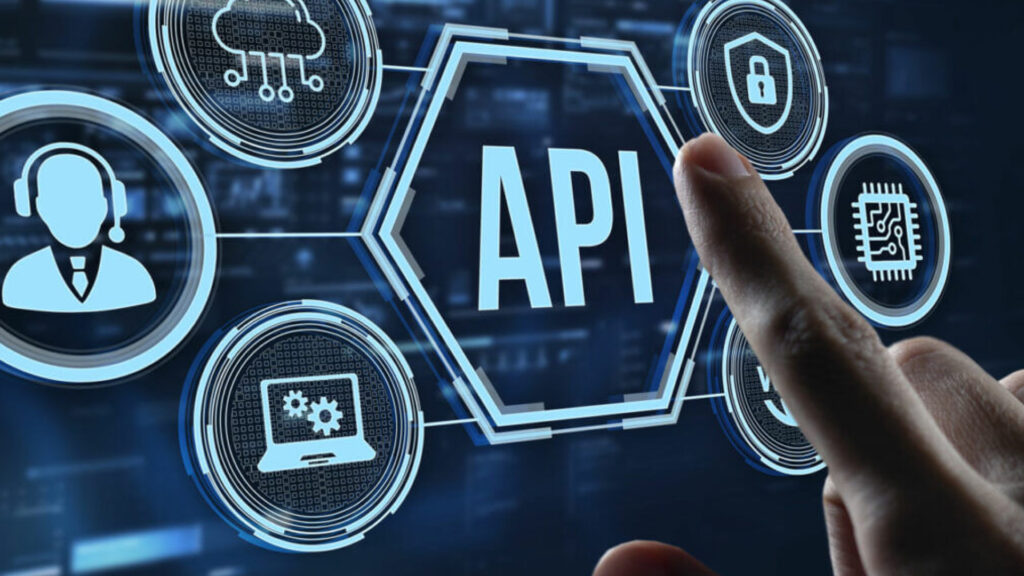Demystifying API Lifecycle: Unpacking Essential Roles, Responsibilities and Their Challenges
May 20, 2025
Read time: 16 minutes
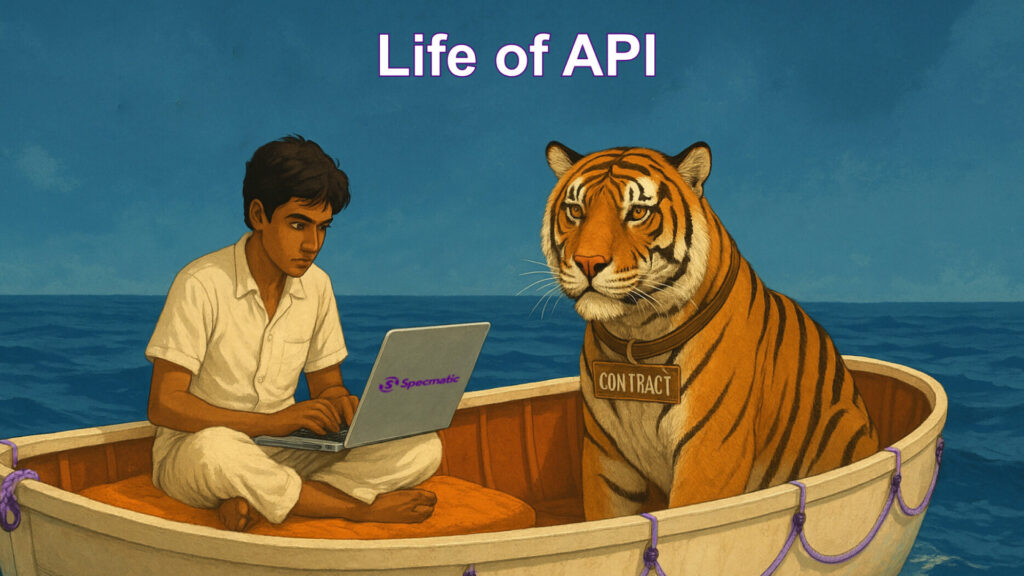
Article Overview
APIs are the invisible glue of modern digital ecosystems – powering microservices, enabling integrations, and accelerating innovation. But building and scaling successful APIs takes more than clean code, good documentation and enterprise governance. It requires a deep understanding of the API lifecycle from both provider and consumer perspectives, and the often-overlooked roles that bring it all together. In this article, I unpack the essential responsibilities and real-world challenges faced by API Product Managers, Architects, Developers, Testers, InfoSec teams, and more – so we can move beyond theory and design APIs that thrive in production.
What is an API lifecycle? Every API product company has its own version of the lifecycle; based on my experience, here is my take:
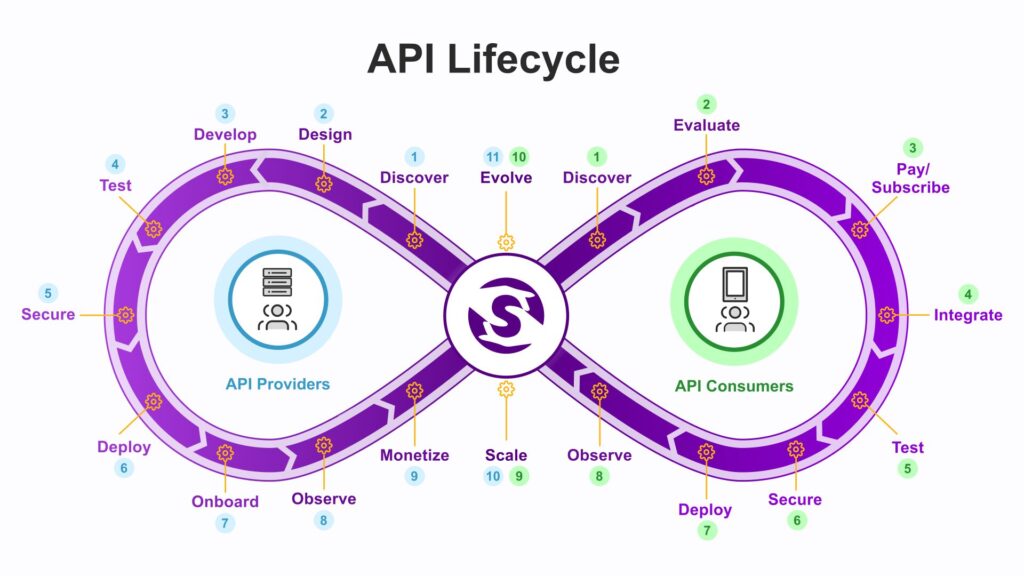
Exploring the API Lifecycle from Provider & Consumer Perspectives
Looking at the API lifecycle from both the provider and consumer point of view is important, as the stages, roles, and responsibilities can vary significantly:
API Provider Perspective
| Role | Lifecycle Stages | Key Responsibilities | Typical Challenges |
| API Product Manager | Discover, Design, Onboard, Observe, Monetize, Scale, Evolve | Market research, define API product value, onboarding strategy, monetization model, measure success metrics | Balancing consumer needs vs. business objectives, selecting appropriate metrics, aligning monetization and value delivery |
| Integration / Solution Architect | Discover, Design, Secure, Deploy, Observe, Scale, Evolve | API landscape planning, interoperability, effectively designing with sync and async API patterns, versioning, security architecture, scalability strategy, Regulatory & Industry Compliance | Avoiding tight coupling, dependency management, API drift, backward compatibility, API discovery, architectural complexity, scalability concerns, reuse between sync and async, API governance, Postel’s Robustness Principle vs Hyrum’s Law |
| Head of Platform | Design, Develop, Secure, Deploy, Onboard, Observe, Scale, Evolve | Set API standards, ensure consistent DevEx, build shared tools, automate deployments, facilitate observability | Ensuring adoption of API standards and specifications, managing consistent Developer Experience, tool selection, seamless integration of API tooling in CI/CD pipelines, handling divergence across teams |
| Senior Tech Leader | Design, Develop, Test, Secure, Deploy, Observe, Scale, Evolve | Guide technical choices, oversee architecture quality, ensure scalability, manage technical debt | Balancing short-term delivery and long-term sustainability, ensuring technology alignment, managing tech debt, mentoring teams on sync and async API design patterns |
| Provider API Developer | Design, Develop, Test, Secure, Deploy, Onboard, Observe, Scale, Evolve | Design intuitive APIs, ensure secure & performant implementation, maintain backward compatibility, keep API documentation up-to-date and in-sync with actual implementation | Balancing stable API design and extensibility, avoiding API drift, documenting API specs with good examples, handling security vulnerabilities, ensuring backward compatibility, performance engineering |
| Integration Tester | Test, Secure, Deploy, Observe, Scale, Evolve | Validate API contracts, test API resilience, automate integration testing, monitor API reliability | Comprehensive test coverage, shift-left integration issue detection, API resiliency testing, effective handling of complex integration scenarios, effective API test automation |
| InfoSec Specialist | Design, Develop, Test, Secure, Deploy, Observe, Scale, Evolve | Establish security policies, vulnerability assessments, regulatory compliance, monitor threats | Balancing strong security and ease-of-use, shift-left threat detection and mitigation, managing compliance standards, Zombie APIs |
| DevOps Engineer / SRE | Develop, Test, Deploy, Observe, Scale, Evolve | Automate deployments, setup observability, monitoring and alerting, ensure operational excellence, manage scalability | Minimizing downtime, maintaining high availability, balancing CI/CD agility with stability, effective automation, proactive issue detection |
API Consumer Perspective
| Role | Lifecycle Stages | Key Responsibilities | Typical Challenges |
| API Product Manager | Discover, Evaluate, Pay/Subscribe, Observe, Scale, Evolve | Identify relevant external APIs, manage cost-value ratio, evaluate usage effectiveness, provide feedback | Accurate evaluation of external API quality, managing vendor lock-in, aligning cost to derived value |
| Integration / Solution Architect | Discover, Evaluate, Integrate, Secure, Deploy, Observe, Scale, Evolve | Design integration architecture, ensure resilience, manage dependencies, architect for security & scaling | Loosely coupled architecture, handling external API drift, designing fault-tolerance, standardise integration patterns to manage integration complexity |
| Head of Platform | Evaluate, Integrate, Secure, Deploy, Observe, Scale, Evolve | Define API consumption standards, provide shared tooling, streamline onboarding, improve internal DevEx | Managing external API fragmentation, enforcing consistent standards across internal and external teams, integrating DevEx tooling for third-party APIs |
| Senior Tech Leader | Evaluate, Integrate, Secure, Deploy, Observe, Scale, Evolve | Guide architectural and technical alignment of external API integrations, ensure scalability and reliability | Balancing innovation with risk from external dependencies, managing vendor-related tech debt, guiding teams through evolving APIs |
| Integration Tester | Integrate, Test, Secure, Deploy, Observe, Scale, Evolve | Validate integration correctness, reliability testing, monitor API usage, regression testing | Handling external API instability, maintaining effective integration tests, rapidly identifying changes, backward compatibility testing |
| InfoSec Specialist | Evaluate, Integrate, Secure, Deploy, Observe, Scale, Evolve | Secure integration points, compliance monitoring, audit external data flows, ensure regulatory compliance | Maintaining internal security despite limited control over external APIs, data privacy compliance, rapidly identifying changes |
| DevOps Engineer / SRE | Integrate, Test, Deploy, Observe, Scale, Evolve | Automate integration deployments, external API monitoring, handle scalability, manage incidents | Managing external provider outages, monitoring external APIs effectively, balancing rapid deployment with stability |
Cross-cutting Challenges in Microservices APIs
| Challenge | Description | Roles Impacted |
| API Drift | Misalignment between API implementation and published contract, causing integration failures | Architect, Developers, Integration Testers, API Product Managers |
| SDK Management | Keeping consumer SDKs accurately aligned and promptly updated with provider API changes | Developers, Architects, Head of Platform, Sr. Tech Leader, DevOps/SRE, Product Managers |
| AI, GenAI & Automation | Leveraging AI for monitoring, anomaly detection, adaptive documentation, predictive analytics, autonomous scaling, and enhanced DevEx (e.g., using Model Context Protocol (MCP)) | Head of Platform, Architects, Sr. Tech Leader, DevOps/SRE, Developers, Product Managers |
Deep Dive into API Lifecycle Roles & Responsibilities
Now let’s have a more detailed deep dive into each role, their responsibilities and more importantly their challenges:
API Provider Perspective
1. API Product Manager
Responsibilities:
- Discover: Understand market needs and opportunities. Defines the strategic vision, and roadmap for APIs as products.
- Design: Clearly define API value proposition and target audience.
- Onboard: Ensure smooth consumer onboarding and effective documentation.
- Observe: Gather consumer insights, usage analytics, and feedback.
- Monetize: Establish pricing models, subscription tiers, and revenue streams.
- Scale: Plan for business and usage scalability.
- Evolve: Continuously refine API offering based on feedback and market trends.
Challenges:
- Product-market fit: Ensuring APIs deliver real value to consumers, addressing their business needs clearly and effectively.
- Lifecycle management: Managing the API lifecycle from inception through growth, maturity, and eventual deprecation. Balancing consumer expectations against technical constraints and business objectives.
- Consumer engagement and feedback loops: Establishing effective channels to collect and act upon consumer feedback, driving continuous improvement.
- Pricing and monetisation: Determining if/how to monetise APIs, balancing revenue potential with adoption growth. Developing monetisation models that reflect consumer-perceived value.
- Measuring success (KPIs): Identifying meaningful success metrics (usage, retention, reliability, business value delivered) and tracking them effectively.
2. Integration / Solution Architect
Responsibilities:
- Discover/Design: Architect comprehensive API landscapes, manage API interdependencies, ensure design standards and adherence to domain model.
- Secure: Define robust API security patterns.
- Deploy: Oversee API deployment strategies, including versioning, backward compatibility and deprecation.
- Observe/Scale/Evolve: Ensure ongoing performance and scalability; manage architecture evolution as consumer needs and technologies change.
- Regulatory and Industry Compliance: Map API designs and operational controls to directive‑specific rules, provide evidence of conformance / compliance to regulators, support new mandates.
Challenges:
- Complexity of managing dependencies: Ensuring the architecture remains manageable as more microservices and integrations are added, dealing with intricate dependencies and inter-service communication. Avoiding tight coupling and ensuring loosely coupled architecture
- Closing the loop: Often architects envision a specific architecture with detailed integration patterns. However, they don’t have the necessary feedback mechanism to ensure the actual implementation has not drifted away from their vision.
- Managing versioning and compatibility: Ensuring backward and forward compatibility across microservices to minimise disruption during API changes or upgrades. Managing API Deprecation and handling their EOL with smooth transition and avoiding disruption.
- Resilience and fault tolerance: Handling complexity from numerous interdependent services and maintaining resilience in integrations. Designing systems that gracefully handle service failures, latency spikes, and network disruptions.
- Observability and monitoring: Maintaining visibility across all microservices, understanding integration points, and quickly diagnosing integration issues.
- Maintaining Conformance / Compliance with Regulatory and Standards Bodies: Making sure that API / service implementations are considering all API design aspects required to maintain conformance and to remain certified where applicable. Also to handle ambiguity in API specifications and conformance profiles provided by regulatory and standards bodies.
- Postel’s Robustness Principle vs Hyrum’s Law: Striking the right balance between inbound tolerance and strictness in validation to either drive adoption vs maintain ability to evolve without unintentionally breaking backward compatibility.
3. Head of Platform
Responsibilities:
- Design/Develop: Set API standards and guidelines, build internal tools/platforms for developers, and streamline DevEx.
- Secure/Deploy: Standardise security practices and automate deployment pipelines.
- Onboard: Simplify onboarding for API consumers and internal development teams.
- Observe/Scale: Provide platform-wide monitoring and manage scalability concerns.
- Evolve: Regularly update standards, practices, and tools to match evolving technological needs.
- Think of the Head of Platform as creating the “highway and traffic system” so thousands of microservice “cars” can safely, quickly, and predictably move.
Challenges:
- Platform cohesion vs team autonomy: Balancing the need for uniformity (standard APIs, security, logging, tracing, deployment) with the desire of service teams to move fast and independently.
- Developer experience (DevEx): Building internal platforms (API gateways, service meshes, contract testing tools, CI/CD systems, observability stacks) and practices (API design first, BDD, TDD, continuous deployments, etc.) that are reliable, easy to use, flexible and empower teams from a self-service point of view rather than slow them down.
- Internal API marketplace / service catalog: Maintaining a well-documented, discoverable, versioned registry of APIs/microservices that developers can trust and reuse.
- Governance and standardisation: Defining and enforcing standards across diverse services, including API contracts, security protocols, and data consistency. Managing API drift and maintaining contract consistency
- Cost optimisation: Reducing duplication across teams by providing shared components and services (authentication, billing, notifications, logging, monitoring, etc.).
- Security and compliance at platform level: Ensuring invisible security — APIs/services are secure by default, not by ad-hoc developer effort.
- Platform as a Product mindset: Treating the internal platform like a product — continuously gathering feedback from developers and iterating.
4. Senior Tech Leader
Responsibilities:
- Design/Develop/Test/Secure: Guide technical decisions, maintain architectural coherence, oversee code quality, ensure compliance with standards and drive scalable, sustainable system and API architecture.
- Deploy/Observe/Scale/Evolve: Manage operational excellence, scalability, monitoring strategies, and evolve the technical landscape sustainably.
Challenges:
- Technical vision and coherence: Ensuring individual teams’ microservices and APIs fit together cohesively at an organisation-wide level (no architectural “Frankenstein”).
- API design quality and consistency: Defining what “good APIs” look like — consistent principles for naming, versioning, contract testing, error handling, security, documentation, etc.
- Guiding critical trade-offs: Helping teams choose the right patterns (e.g., synchronous REST vs event-driven), avoid over-engineering, and manage technical debt wisely. Balancing immediate business demands with long-term technology strategy. Keeping pace with rapidly evolving technologies while ensuring sustainable architecture and technical coherence.
- Scaling pain points: Identifying and addressing systemic bottlenecks — for example, too many point-to-point integrations (spaghetti), poor API version control and documentation, fragile integration testing.
- Mentorship and technical decision coaching: Growing technical maturity across teams, not just coding themselves. Amplifying impact through influence rather than authority.
- Tech debt remediation and migration: Leading major platform or architecture migrations (e.g., monolith to microservices, legacy APIs to AsyncAPI event streams).
5. Provider API Developer
Responsibilities:
- Design/Develop/Test/Secure: Develop APIs that are intuitive, stable, secure, scalable, and performant. Ensuring APIs are performant under varying loads, managing throughput, latency, and resource efficiency.
- Deploy/Onboard: Provide clear and comprehensive API documentation, onboarding guides, and good domain specific examples for the APIs.
- Observe/Scale/Evolve: Continuously monitor API performance and quickly adapt APIs to consumer feedback and technical requirements.
Challenges:
- API Spec Conformance: Ensuring there is no API drift, that is the API implementation is actually adhering to the API specification.
- API contract stability: Balancing the evolution of APIs with maintaining backward compatibility, maximising schema reuse, handling versioning effectively to prevent consumer disruptions.
- Performance optimisation: Ensuring APIs are performant under varying loads, managing throughput, latency, and resource efficiency.
- Security management: Protecting the API endpoints from vulnerabilities, securing data, and managing authentication and authorisation effectively. Quickly addressing security vulnerabilities.
- Documentation and clarity: Creating comprehensive, up-to-date, easily consumable documentation with examples that help consumers to easily understand the usage patterns and constraints. Designing APIs with long-term stability and minimal drift.
- Change communication: Communicating clearly and timely with consumers about upcoming changes, deprecated endpoints, or breaking changes.
6. Integration Tester
Responsibilities:
- Test/Secure/Deploy: Validate API functionality, contract correctness, security, resilience, and overall integration robustness. Ensuring APIs and their consumers work harmoniously and reliably.
- Observe/Scale/Evolve: Continuously monitor reliability, performance, and regression issues, adjusting tests to evolving integrations.
Challenges:
- Complex scenarios: Testing a wide range of integration scenarios, including edge cases, concurrency issues, asynchronous behaviour, and event-driven interactions. Achieving comprehensive test coverage across diverse and rapidly changing APIs.
- Environment complexity: Maintaining realistic testing environments and data sets that accurately reflect production, especially when numerous microservices and integrations are involved.
- Data isolation and dependency management: Isolating tests from each other to ensure repeatable, reliable results despite shared or dependent services.
- Change management and regression: Managing frequent changes in APIs, quickly adapting tests to new behaviours or API versions while ensuring no regressions.
- Observability and diagnostics: Quickly pinpointing and diagnosing integration issues, distinguishing provider versus consumer-side problems.
- Bottleneck prevention: Lack of shift-left approach can lead to majority issues being identified late in the cycle during integration testing leading to extremely tight timelines for test cycles which increases risk of bug leakage to higher environments.
7. InfoSec Specialist
Responsibilities:
- Design/Secure/Deploy: Ensures the microservices architecture and APIs are secure, compliant, and resilient against vulnerabilities and threats. Develop and enforce API security policies, manage regulatory compliance and privacy standards.
- Observe/Evolve: Continuously audit APIs for vulnerabilities and adjust practices according to emerging security threats and standards.
Challenges:
- API threat surface management: Continuously assessing APIs for vulnerabilities, OWASP top-10 risks, and proactively managing potential threats.
- Authentication & authorisation: Enforcing robust authentication and fine-grained authorisation across microservices, especially in complex distributed environments. E.g. RBAC, ReBAC and others.
- Compliance & regulatory adherence: Ensuring that APIs adhere to standards like GDPR, HIPAA, PCI DSS, and industry-specific regulations.
- Continuous security monitoring: Implementing security scanning, audit logging, and real-time threat detection across multiple APIs and services.
- Security-by-design culture: Promoting secure coding practices and training development teams to anticipate security concerns proactively. E.g. Thorough input validation to prevent spurious input that can impact data integrity and cause other serious security risks. Balancing robust security with developer ease-of-use.
- Zombie APIs: Detecting and decommissioning APIs that are no longer in active use, without active maintenance and / or updates.
8. DevOps Engineer / SRE
Responsibilities:
- Develop/Test/Deploy: Automate API deployment, integrate CI/CD pipelines, and manage release cycles.
- Observe/Scale/Evolve: Ensure operational stability, observability, proactive monitoring and alerting, manage scalability strategies, incident response, and infrastructure evolution.
Challenges:
- Automation complexity: Ensuring smooth and automated deployments of APIs with zero-downtime or impact to consumers.
- Infrastructure scaling and reliability: Ensuring microservices infrastructure scales dynamically under varying loads, with resilience to handle failure gracefully.
- Environment consistency: Creating uniformity across multiple development, testing, staging, and production environments to reduce configuration drift.
- Chaos Testing: Injecting faults and testing the resiliency of the overall system. Designing SOPs to minimise downtime and ensuring rapid recovery from incidents.
- Observability & monitoring: Implementing comprehensive monitoring solutions to provide deep visibility into the health, performance, and reliability of APIs.
- Incident response & rollback mechanisms: Quickly detecting and responding to deployment failures, performance degradations, or unexpected incidents, with efficient rollback strategies.
API Consumer Perspective
1. API Product Manager (Consumer-side)
Responsibilities:
- Discover/Evaluate: Identify external APIs matching business needs; evaluate quality, pricing, reliability.
- Pay/Subscribe: Select suitable subscription models ensuring cost-effectiveness.
- Observe/Scale/Evolve: Continuously monitor API value realisation and provide constructive feedback to providers for improvements.
Challenges:
- Accurately assessing external API reliability and long-term viability.
- Avoiding vendor lock-in and dependency risks.
- Clearly articulating evolving requirements to API providers.
2. Integration / Solution Architect (Consumer-side)
Responsibilities:
- Evaluate/Integrate/Secure/Deploy: Design robust integrations, secure endpoints, manage API dependency risks.
- Observe/Scale/Evolve: Monitor external APIs, manage integration complexities, and adjust architecture proactively.
Challenges:
- Handling unpredictable changes and API drift from external providers.
- Designing robust integration patterns for fault tolerance.
- Ensuring seamless scaling with external dependency limitations.
- Working with API Designs that may not be taking into account consumer point of view and feedback.
3. Head of Platform (Consumer-side)
Responsibilities:
- Evaluate/Integrate: Define internal standards and guidelines for consuming external APIs across teams.
- Secure/Deploy: Provide shared infrastructure (e.g., API gateways, token managers, sandbox environments) to securely integrate with third-party APIs.
- Observe: Centralise logging, usage metrics, and performance insights from consumed APIs.
- Scale: Offer scalable tooling and shared services (e.g., SDKs, internal API wrappers) for teams working with external APIs.
- Evolve: Continuously update internal best practices and platforms to align with new external API capabilities and organisational growth.
Challenges:
- Enforcing consistent integration patterns and observability across multiple teams and third-party APIs.
- Managing fragmentation when different teams independently consume diverse external APIs.
- Balancing centralised platform control with team autonomy and innovation.
4. Senior Tech Leader (Consumer-side)
Responsibilities:
- Evaluate/Integrate/Secure: Oversee technical feasibility and security implications of integrating with third-party APIs.
- Deploy/Observe: Ensure architectural consistency and scalable use of external APIs across the tech landscape.
- Scale/Evolve: Guide teams to manage tech debt from evolving API integrations, promote strategic API reuse, and plan long-term integration architecture.
Challenges:
- Managing technical risks introduced by third-party dependencies.
- Aligning integration decisions with broader system architecture and business goals.
- Preventing proliferation of redundant or low-quality external API integrations.
- Leading proactive planning for change management and fallback strategies when APIs are deprecated or altered.
- Striking the right balance for defensive coding.
5. Consumer API Developer
Responsibilities:
- Integrate/Test/Secure/Deploy: Effectively integrate external APIs, build resilient and secure interactions.
- Observe/Scale/Evolve: Implement monitoring, error handling, rapid recovery mechanisms; efficiently evolve integrations alongside provider updates.
Challenges:
- Discoverability of APIs: Finding and understanding available APIs, how to use them effectively, and knowing their limitations.
- Handling changes and versioning: Keeping up with API changes, adapting quickly to new versions or deprecated endpoints without affecting the consumer application.
- Error handling and resilience: Implementing appropriate retry, fallback, and error-handling mechanisms in response to provider-side issues.
- Performance and latency: Dealing with API latency, understanding response times, and ensuring minimal impact on application responsiveness.
- Chaos Testing: Testing resiliency of your component by injecting faults via API dependencies.
- Data consistency: Ensuring the correct interpretation and mapping of data across multiple services and ensuring data integrity in business workflows.
6. Integration Tester (Consumer-side)
Responsibilities:
- Integrate/Test/Deploy/Observe: Ensure thorough end-to-end testing, continuously monitor external integrations, validate against breaking changes.
- Scale/Evolve: Adjust tests dynamically as integrations scale and APIs evolve.
Challenges:
- Maintaining reliable test suites despite external API variability.
- Quickly identifying and mitigating impacts from external API changes.
- Ensuring test environments accurately simulate external APIs.
7. InfoSec Specialist (Consumer-side)
Responsibilities:
- Secure/Deploy/Observe: Secure external API integrations, ensure adherence to compliance requirements, monitor and audit data flows continuously.
Challenges:
- Ensuring internal security standards are upheld despite limited control over external APIs.
- Proactively identifying and mitigating risks from external data exchange.
- Staying compliant with external provider terms and regulatory obligations.
8. DevOps Engineer / SRE (Consumer-side)
Responsibilities:
- Deploy/Observe/Scale/Evolve: Automate integration deployments, monitor external APIs proactively, scale integrations efficiently, handle external API failures gracefully.
Challenges:
- Managing external provider outages and instability.
- Implementing effective monitoring to anticipate external disruptions.
- Balancing internal agility with dependency on external services.
Cross-Cutting Challenges
- API Drift: Ensuring API implementations align consistently with contracts, avoiding integration failures.
- SDK Management: Maintaining consumer SDK accuracy amidst provider API changes.
- AI, GenAI, & Automation: Leveraging advanced analytics and AI tools for real-time API monitoring, adaptive documentation, anomaly detection, predictive scaling, improved developer experience (DevEx), and automated response through approaches like Model Context Protocol (MCP).
Do these challenges resonate with you? Am I missing any challenges?
Comment on LinkedIn
Related Articles
September 17, 2025
Read time: 4 mins
Spec Driven Development: Beyond the first feature with API Design First
September 9, 2025
Read time: 4 mins
Spec Driven Development: API Design First with GitHub Spec Kit and Specmatic MCP
September 2, 2025
Read time: 3 mins
Guardrails for API Development: Guiding Coding Agents with Specmatic MCP
March 13, 2023
Read time: 6 mins
Contract-Driven Development – a Real-World Adoption Journey
January 17, 2023
Read time: 4 mins
Integration Hell [Contract Driven Development – Post 2]
December 30, 2022
Read time: 3 mins
The trouble with API mocks and stubs [Contract Driven Development – Post 1]
December 29, 2022
Read time: 10 mins

